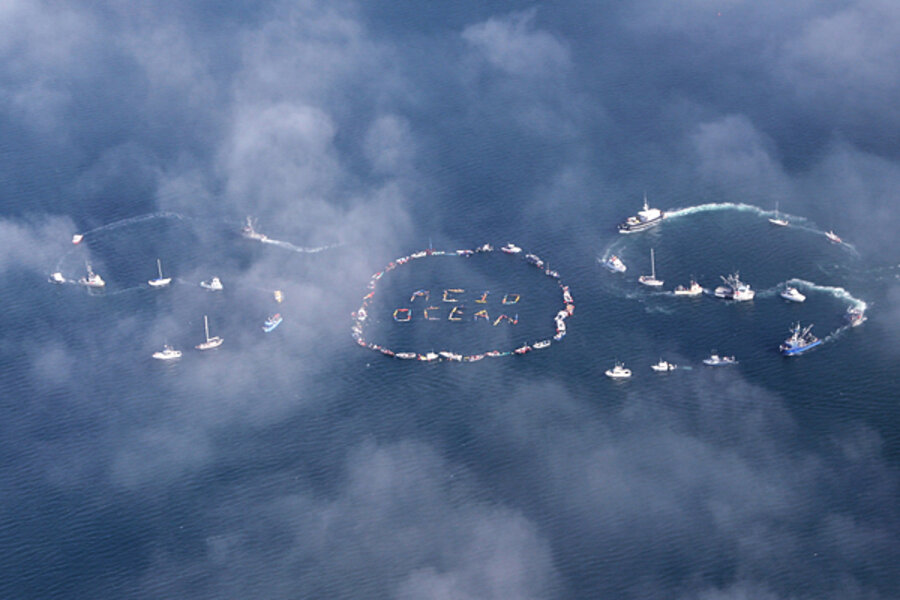At Copenhagen global warming conference, alarms on ocean acidification
Loading...
| Copenhagen, Denmark
Walk the halls at the cavernous Bella Conference center and it's no surprise that global warming gets all the buzz, all the time. Carbon dioxide's other effect, to increase the acidity of sea water, is a bit like the toddler constantly tugging at the trouser legs of its elders, asking: "What about me?"
On Monday, the UN Convention on Biological Diversity attempted to strengthen that tug by releasing a "synthesis report" on ocean acidification. The oceans' acidity has increased 30 percent over the last 250 years. But at current carbon-dioxide emission rates from factories, power plants, and other human activities, ocean acidity could increase by 150 percent by 2050, according to the survey of recent research on the subject.
If that occurs, it would represent an increase some 100 times faster than ocean life has experienced in the last 20 million years – a rate that outpaces the ability of shell-building marine life to adapt to the shift through evolution. As the oceans become more acidic, they eat into stores of carbonate minerals dissolved in seawater. Many ocean animals use various forms of these carbonates to build shells, or in the case of corals, to generate the skeletons they live in and that form coral reefs.
Humans rely on many of these animals indirectly, since they serve as food for large fish. And they rely on some of them directly as food – lobsters, clams, oysters, conch, and a range of other high-value creatures. In the case of corals, reefs provide a dual benefit as nurseries for fish, and as a first barrier against coastal erosion from high waves and storm surges.
The bottom line: Even if carbon dioxide had no effect on climate, burning fossil fuels – a process that releases CO2 sequestered deep underground for millions of years – would still alter the oceans and the marine life it supports.
“Ocean acidification is irreversible on timescales of at least tens of thousands of years," said Ahmed Djoghlaf, executive secretary of the biodiversity convention in a statement. "Substantial damage to ocean ecosystems can only be avoided by urgent and rapid reductions in global emissions of CO2. "
Arctic a risk
Some of the fastest rates of acidification are coming in oceans at high latitudes. The report notes that at current CO2 emission rates, the Arctic Ocean will show a deficit of carbonate minerals essential for marine life by 2032 – accelerated in part by the infusion of carbonate-poor melt water from the Arctic Ocean's ice cap. Global warming, along with regional wind patterns, have combined to shrink the extent and volume of the Arctic's sea ice to levels not seen since the beginning of satellite records in 1979.
At a side event at the climate conference yesterday, a panel that included former Sen. Al Gore, suggested that the Arctic Ocean would be virtually ice free in the summers by 2014, although many Arctic scientists say that's unlikely to happen until 2030 at the earliest.
Another acidification hot spot is the Southern Ocean, which surrounds Antarctica. The synthesis report suggests that the Southern Ocean will become undersaturated in essential carbonates by 2050. Yet the effect on marine life could come much sooner.
Last December, researchers from Australia showed that a tipping point for tiny marine organisms that sit at the bottom of the food chain could come as early as 2030. The reason: In addition to ocean acidification from human CO2 emissions, key locations in the Southern Ocean are sites where cold, carbonate-poor waters rise up as part of the ocean's natural circulation. The one-two punch for critters hits in the southern winter, when tiny juvenile pteropods -- the potato chips of the ocean -- are forming their shells. They have adapted to growing shells despite the upwelling. But the added acidification from human CO2 could outstrip their ability to adjust.
If the chemistry behind ocean acidification is straightforward, the potential biological effects are less so.
In a study published in the current issue of the journal Geology, a team led by Justin Ries, currently a marine scientist at the University of North Carolina, shows some intriguing diversity in the way different species of shell-builders responds to rising ocean acidity.
The team subjected 18 species of marine creatures -- from lobsters and conch to temperate corals -- to waters exposed to various levels of atmospheric CO2 levels. Those levels ranged from current atmospheric concentrations, to 2, 3, and 10 times preindustrial levels.Ten of the 18 organisms displayed either slower rates of shell-building or outright erosion of shells at increased atmospheric CO2 levels. But seven showed increased rates of shell building at mid- and high-level atmospheric concentrations.
In an email, Dr. Ries says his work now focuses on uncovering the reasons for the differences.





